Osprey at War
Can the MV-22 pass muster in Afghanistan?
/https://tf-cmsv2-smithsonianmag-media.s3.amazonaws.com/filer/Osprey%20at%20War%20FL.jpg)
Camp Bastion, the British headquarters in Helmand province in the south of Afghanistan, is built in the middle of the desert for a reason. There are no villages nearby. An enemy would have to walk through miles of open and flat desert to attack.
It’s a tent city, four miles long and two miles wide, with a field hospital and an airstrip. The runway is short, barely long enough to handle the C-17 cargo aircraft that roar in and out of the base each day. The camp sits adjacent to Camp Leatherneck, headquarters of the 2nd Marine Expeditionary Brigade.
Helicopters crowd Bastion’s airfield: CH-53D Sea Stallions, CH-53E Super Stallions, Bell UH-1Y Venoms, and AH-1W Super Cobras. In the rough terrain and roadless expanses of Afghanistan—and over roads hiding improvised explosive devices—helicopters are often the only practical means of transportation for U.S. Marines. Until last November, that is. That’s when Camp Bastion became home to the tiltrotor MV-22 Osprey and Marine Medium Tiltrotor Squadron 261 (VMM-261), the first Osprey squadron deployed to Afghanistan.
Just four weeks after arriving, the Ospreys went on the offensive. On December 4, 2009, the MV-22s inserted an 80-person reconnaissance force near the town of Now Zad in northern Helmand. Operation Cobra’s Anger was meant to shut down the Taliban’s line of communications, and the routes through which their fighters and weapons move.
The Osprey’s primary role in Cobra’s Anger was insertion: carrying 24 Marines like a bat out of hell to combat. Although it did the job in Now Zad and, more recently, Marja, the MV-22’s main work in Afghanistan so far has been assault support, transporting personnel and supplies of all types—from mail to bullets to diesel-engine parts—to a series of austere combat outposts throughout Helmand. That mission had been the task of the CH-53 helicopter. (The Marine Corps is replacing the venerable CH-46 Sea Knight, which doesn’t do well in Afghanistan’s high elevations, with the MV-22.)
The Osprey is not just a newly fielded aircraft but an entirely new type of aircraft, the first transport in operation that can take off and land vertically like a helicopter, but that offers the speed and range of many fixed-wing aircraft. “When you’re going to a place without a runway, you need a rotorcraft. When you’re going a long way to a place without a runway, you need a tiltrotor,” says Lieutenant Colonel Anthony Bianca, VMM-261’s commanding officer.
This is only the fifth combat deployment for the Osprey (including three tours in Iraq, and a shipboard deployment), a platform that was certified operational just four years prior to its arrival in Afghanistan. The Osprey is enduring more scrutiny than most new aircraft types, because during its development, four Ospreys had high-profile crashes, including one during an operational evaluation in 2000 in which all four crew members and 15 passengers were killed. Major Timothy Miller, -261’s operations officer, says, “For a lot of people, the V-22 is an unknown. There are misconceptions, so you have to do some education up front, and attempt to allay people’s concerns.”
From his tent office on the flightline at Bastion’s airfield, Lieutenant Colonel Ivan Thomas, executive officer of VMM-261, summarizes the Osprey’s advantages. It’s twice as fast as a CH-46 and can carry double the payload. The Osprey can fly above the ground threats posed by the enemy in Afghanistan, including small-arms fire and shoulder-launched surface-to-air missiles.
For additional protection, the Osprey’s powerful engines allow pilots to launch the aircraft vertically and “corkscrew” to altitude directly above the safety of a base.
The launch is unlike anything else. “It felt like getting shot to the moon,” recalls Gunnery Sergeant Steve Morris, who was on the original reconnaissance team inserted into Now Zad. “Your stomach goes to your ankles; it’s a really heavy feeling.”
This morning I get to feel that sensation for myself, as I ride along on a resupply mission. Once loaded and fueled, two MV-22s taxi onto the main runway. With all diagnostic indicators on the aircraft’s multi-function displays in the OK, and with clearance from the tower, our Osprey lifts into the air from a dead standstill, the other from a slow roll. As the aircraft begins its smooth arc forward, one of the pilots asks the crew chief, “Ready to go fast?”
“Roger.”
Lieutenant Colonel Bianca, one of the program’s longest-serving Osprey pilots (he has 1,600 hours as an MV-22 pilot), says of passengers at this point in their first flight: “Open up the throttles and pull the nose back, and you should see the look of incredulity on their faces.” With one hand on the thrust control lever and another on the control stick (which in helicopter mode works like a cyclic and in airplane mode like a regular airplane control stick), the pilot rotates the two nacelles forward toward airplane mode, and the aircraft’s smooth upward arc is replaced by slight buffeting. With the airspeed indicator parked at 180 knots (the top speeds of the fastest production military helicopters range between 150 and 170 knots), the pilot pulls back on the stick, making a hard-right bank and corkscrewing the Osprey steeply upward. “You can tell when a grunt has flown on the MV-22 before by the way he cinches down the straps and holds on to the shoulder strap that’s towards the front of the aircraft,” says Bianca. “He knows what kind of acceleration is coming.”
And accelerate it does, its powerful engines enabling it to climb at thousands of feet per minute. Once at altitude, the speed indicator pushes up to about 230 knots, although the Osprey can go much faster. After just a few minutes of flying, we corkscrew back down, and with a rattle reminiscent of a loud lawnmower engine, the nacelles transition back into helicopter mode, and the craft drops onto a landing zone at a combat outpost near the Helmand River.
As the aircraft approaches the ground, stacks of large container boxes rise into view, then dust flies up. Another container box, this one just eight feet in front of the nose, emerges from the dust. The Osprey smoothly touches down. Marines crammed in the back file out a side door as a forklift pulls out two “tri-walls”—large tote boxes made of triple-layer paperboard—full of supplies. At many outposts, the Osprey’s powerful engines create a brownout, a blinding plume of dust. On this landing, the air is relatively clear. Pointing to river rocks that Marines have taken from the Helmand and spread over the landing zone, Major Will Grant explains that the improvised surface has created better visibility for landing here.
Once all passengers and their gear have been stowed, the Osprey again rises straight up into the sky.
The Marines of VMM-261 understand their place in V-22 history. The squadron’s experiences, particularly combat deployments, will have far-reaching consequences, and the squadron’s suggestions will help determine not only what hardware gets used, but also potential software upgrades.
“We are going to write a whole new chapter in Osprey employment out here,” says Colonel George Amland, deputy commander of the 2nd Marine Expeditionary Brigade. He acknowledges the great strides made by the three MV-22 deployments to Iraq, but notes that the two theaters have many differences. As planners at VMM-261 develop a mission that will take the Osprey from Bastion to the Pakistani border, 850 miles round trip, Amland comments on the Osprey’s benefits.
“The Osprey can collapse the battlespace, and go into areas that are not suitable for landing a [KC]-130J,” he says. And because helicopters are transported to Afghanistan as cargo on a C-5, and the Osprey arrives there under its own power, it can free “a tremendous amount of strategic lift by self-deploying,” says Amland.
The squadron has 10 Ospreys, and missions usually run four to six hours, with some lasting as long as eight. Both aviators and ground crew serve either day or night shifts, but as missions change, flights are often extended, and day pilots often “hot seat” with night pilots, meaning the pilots and crew just swap places while the MV-22 refuels, and the aircraft never shuts down. The squadron is preparing for the coming troop surge, and that, along with the regular day-to-day resupply and delivery operations, keeps the Ospreys running round the clock, 18 or 20 hours straight, requiring maintenance crews to perform basic fixes in between “hops” with the proprotors spinning above them.
The history of the V-22 used to bother Staff Sergeant Brian Freeman. He rejoined the Marine Corps after the September 11, 2001 terrorist attacks, hoping to return to a CH-46 squadron, but his only option was an Osprey unit. “In the beginning, nobody wanted to fly on the Osprey,” Freeman says. The 2000 Osprey crash had killed a friend of his from boot camp. “I went into the program not trusting the aircraft, and with the mentality that the MV-22 was going to have to prove itself to me. And through the years, it did.” (To date, Freeman has logged more than 1,300 hours in the Osprey, one of the highest numbers in the V-22 program.)
Freeman is now convinced that the Osprey is safe. “I like that it tells you what’s wrong with it,” he says. “I like that once you understand how to use the computer system, the multi-function displays, the aircraft will give you information that as a CH-46 guy, you had to know what to smell, what to hear, and really have an intimate knowledge of the aircraft to diagnose. There’s really nothing that I dislike about the Osprey. I used to love flying on the CH-46, until I flew the Osprey. There are lots of things I don’t miss about the CH-46, because the Osprey’s capabilities make that aircraft obsolete.”
Major Larry Nichols came to the squadron after flying single-seat F/A—18C Hornets. “It’s as if a CH-46 and an F-18 had a baby,” he says. “I feel like I’m stealing when I fly the Osprey; it is a fantastic aircraft to fly, taking off like a helicopter and the [high] performance of it in aircraft mode.”
He does think the cockpit design could be improved, and he also has a minor quibble with the software: “The number of keystrokes to get to certain menus is time-consuming and excessive. There are some real tedious steps to manage certain functions that are significantly simpler and more intuitive in a Hornet, specifically regarding communication and navigation.”
Once -261’s seven-month tour is complete, another Osprey unit will take its place—and learn from VMM-261’s
experience. In Afghanistan, for instance, Captain Chris Meixell explains, “Many of us fly the initial leg of the spiral approach a little tighter, as the forward operating bases here are a little smaller than those in Iraq, where the spiral approach was first used for the Osprey.”
Maintenance crews are also learning from the new environment. Sergeant Frank Mershon, an avionics technician, typically works 12 to 16 hours a day, seven days a week. (In addition to his primary job, Mershon is an aerial observer, so he often flies to aid a mission.) “Every day is different,” he says. “We get certain gripes [problems or parts needing repair], and once we get our gripes, we go out and troubleshoot them.” Mershon moved into -261 from a CH-46 squadron. He seems to thrive on the challenges posed by southern Afghanistan’s austerity. “The V-22 is definitely more of a challenge, but it definitely makes you think to the next level,” he tells me in the squadron’s small chow hall, filled with cards and letters from squadron members’ families. “The -46 was pretty simple, and the Osprey is brand new…. We’re experiencing maintenance issues that the Osprey has never experienced before.”
Perhaps the most powerful endorsement comes not from the Osprey squadron’s pilots or maintainers, but from one of its passengers. “The grunts are the proving ground for the Marine Corps. What [the Osprey] does for the grunts is what its true capability is,” says Gunnery Sergeant Morris. “Something may look good at the Miramar airshow, but what does it do for the infantry Marines? And that Osprey, in my opinion, closes the gap.... It is a huge push forward for the infantry.”
At the end of my stay with VMM-261, I asked to visit a remote outpost on the shores of Helmand River. I’d be traveling by Osprey, but this time as an anonymous passenger, not a media embed given the privilege of sitting in the cockpit jumpseat. With the temperature dipping below freezing, I stood with a small group of Marines and civilians as four CH-53s and two Ospreys idled on the edge of the runway.
When given the word, we hustled up the Osprey’s rear ramp, and I wrestled my backpacks onto my lap, crammed so tightly into the aircraft that I could hardly find my seatbelt. When we were all strapped in, the pilots taxied the aircraft onto the runway. By the anticipation on their faces, I could tell that most of the passengers had never flown in an Osprey before. The crew chief made sure everyone knew to hold on; once he’d answered the pilot’s question—“Ready to go fast?”—we’d all shift toward the open rear ramp.
As the Osprey began its spiral climb, I felt the same powerful G-forces as everyone else, although I had one advantage: My watch had an altimeter, so I knew when the steep climb would stop.
After making two stops, we reached my destination, a small camp dotted with tents, generators, and a few high antennas for communication. I dragged my gear out of the way of the rotor wash, then watched as the Osprey disappeared, the only visible lights the dim green glow of the pilot’s night-vision goggles.
Writer and photographer Ed Darack frequently covers U.S. Marine combat operations.
/https://tf-cmsv2-smithsonianmag-media.s3.amazonaws.com/accounts/headshot/ED_DARACK.jpg)
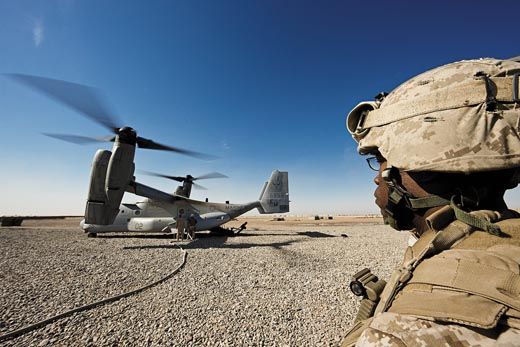
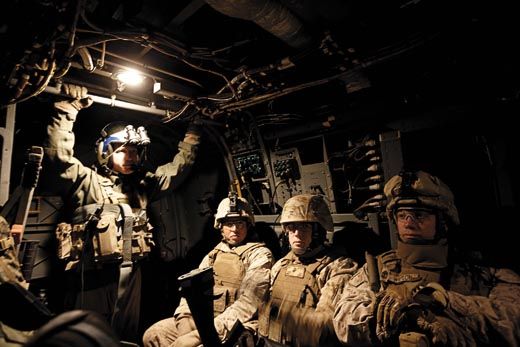
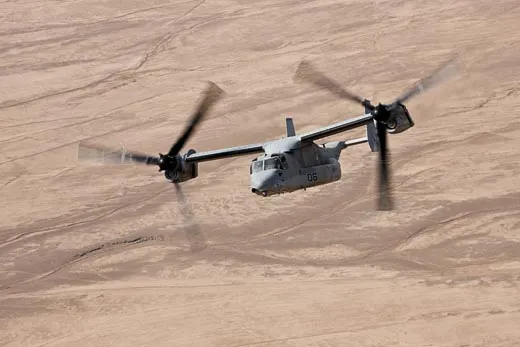
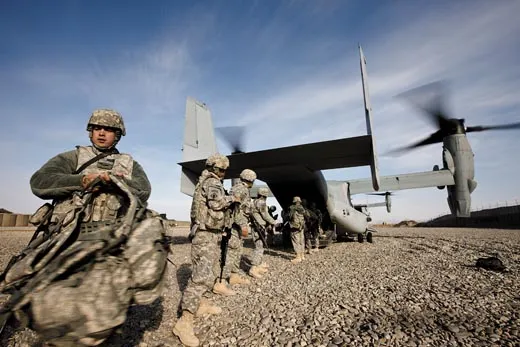
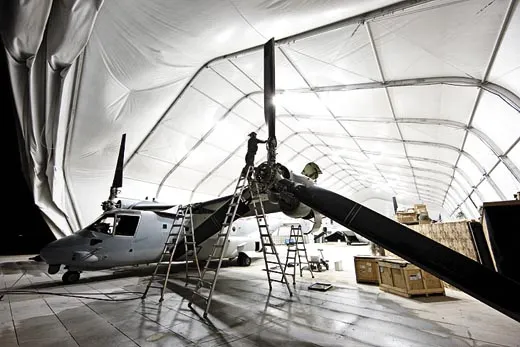
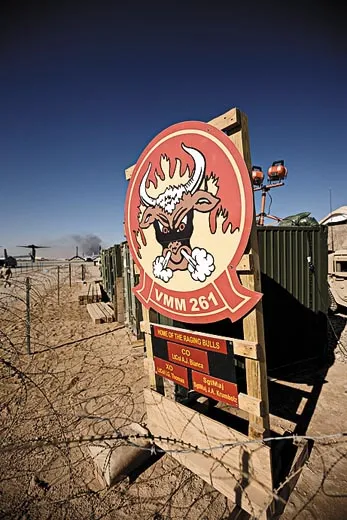
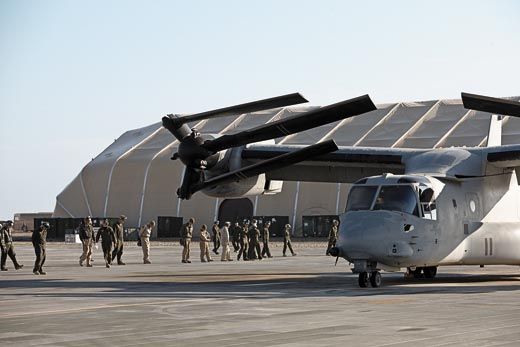
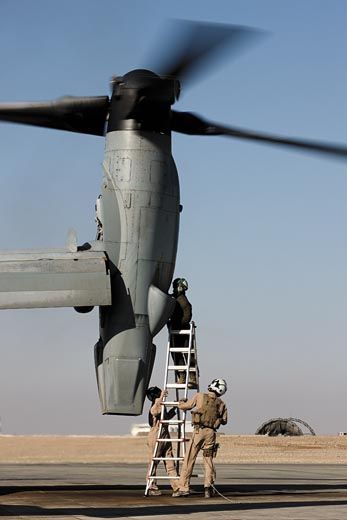
/https://tf-cmsv2-smithsonianmag-media.s3.amazonaws.com/accounts/headshot/ED_DARACK.jpg)